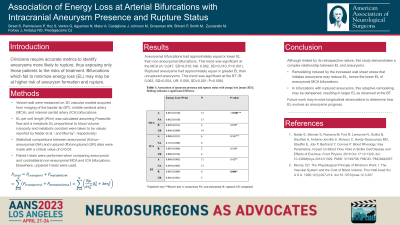Association of Energy Loss at Arterial Bifurcations with Intracranial Aneurysm Presence and Rupture Status
Friday, April 21, 2023


Seth S. Street (he/him/his)
Medical Student
University of Cincinnati College of Medicine
ePoster Presenter(s)
Introduction: Rupture is a rare but serious complication of intracranial aneurysms, but treatment also carries risks. Clinicians require accurate metrics to identify aneurysms more likely to rupture, thus exposing only those patients to the risks of treatment. Observational studies have shown that the radii of healthy arterial bifurcations conform to values which minimize the energy loss (EL) due to transport and metabolic maintenance of blood. Some bifurcations may fail to minimize EL, which could serve as a measure of risk for aneurysm formation and rupture.
Methods: Vessel radii were measured on 3D vascular models acquired from imaging of the basilar tip (BT), middle cerebral artery (MCA), and internal carotid artery (ICA) bifurcations. EL per unit length (W/m) was calculated assuming Poiseuille flow and a metabolic EL proportional to blood volume. Statistical comparisons between aneurysmal (A)/non-aneurysmal (NA) and ruptured (R)/unruptured (UR) sites were made with a critical value of α=0.05. Paired t-tests were performed when comparing aneurysmal and contralateral non-aneurysmal MCA and ICA bifurcations. Elsewhere, unpaired t-tests were used.
Results: MCA bifurcations numbered: 13/13/4/14; ICA: 6/6/2/4; BT: 11/13/6/5 (A/NA/R/UR). Aneurysmal bifurcations had approximately equal or lower EL than non-aneurysmal bifurcations. This trend was significant at the MCA (A: 0.047, SD=0.010; NA: 0.062, SD=0.010; P< 0.001). Ruptured aneurysms had approximately equal or greater EL than unruptured aneurysms. This trend was significant at the BT (R: 0.063, SD=0.004; UR: 0.056, SD=0.001; P=0.006).
Conclusion : Although limited by its retrospective nature, this study demonstrates a complex relationship between EL and aneurysms. Remodeling induced by the increased wall shear stress that initiates aneurysms may reduce EL, hence the lower EL of aneurysmal MCA bifurcations. In bifurcations with ruptured aneurysms, this adaptive remodeling may be dampened, resulting in larger EL as observed at the BT. Future work may involve longitudinal observations to determine how EL evolves as aneurysms progress.
Methods: Vessel radii were measured on 3D vascular models acquired from imaging of the basilar tip (BT), middle cerebral artery (MCA), and internal carotid artery (ICA) bifurcations. EL per unit length (W/m) was calculated assuming Poiseuille flow and a metabolic EL proportional to blood volume. Statistical comparisons between aneurysmal (A)/non-aneurysmal (NA) and ruptured (R)/unruptured (UR) sites were made with a critical value of α=0.05. Paired t-tests were performed when comparing aneurysmal and contralateral non-aneurysmal MCA and ICA bifurcations. Elsewhere, unpaired t-tests were used.
Results: MCA bifurcations numbered: 13/13/4/14; ICA: 6/6/2/4; BT: 11/13/6/5 (A/NA/R/UR). Aneurysmal bifurcations had approximately equal or lower EL than non-aneurysmal bifurcations. This trend was significant at the MCA (A: 0.047, SD=0.010; NA: 0.062, SD=0.010; P< 0.001). Ruptured aneurysms had approximately equal or greater EL than unruptured aneurysms. This trend was significant at the BT (R: 0.063, SD=0.004; UR: 0.056, SD=0.001; P=0.006).
Conclusion : Although limited by its retrospective nature, this study demonstrates a complex relationship between EL and aneurysms. Remodeling induced by the increased wall shear stress that initiates aneurysms may reduce EL, hence the lower EL of aneurysmal MCA bifurcations. In bifurcations with ruptured aneurysms, this adaptive remodeling may be dampened, resulting in larger EL as observed at the BT. Future work may involve longitudinal observations to determine how EL evolves as aneurysms progress.
